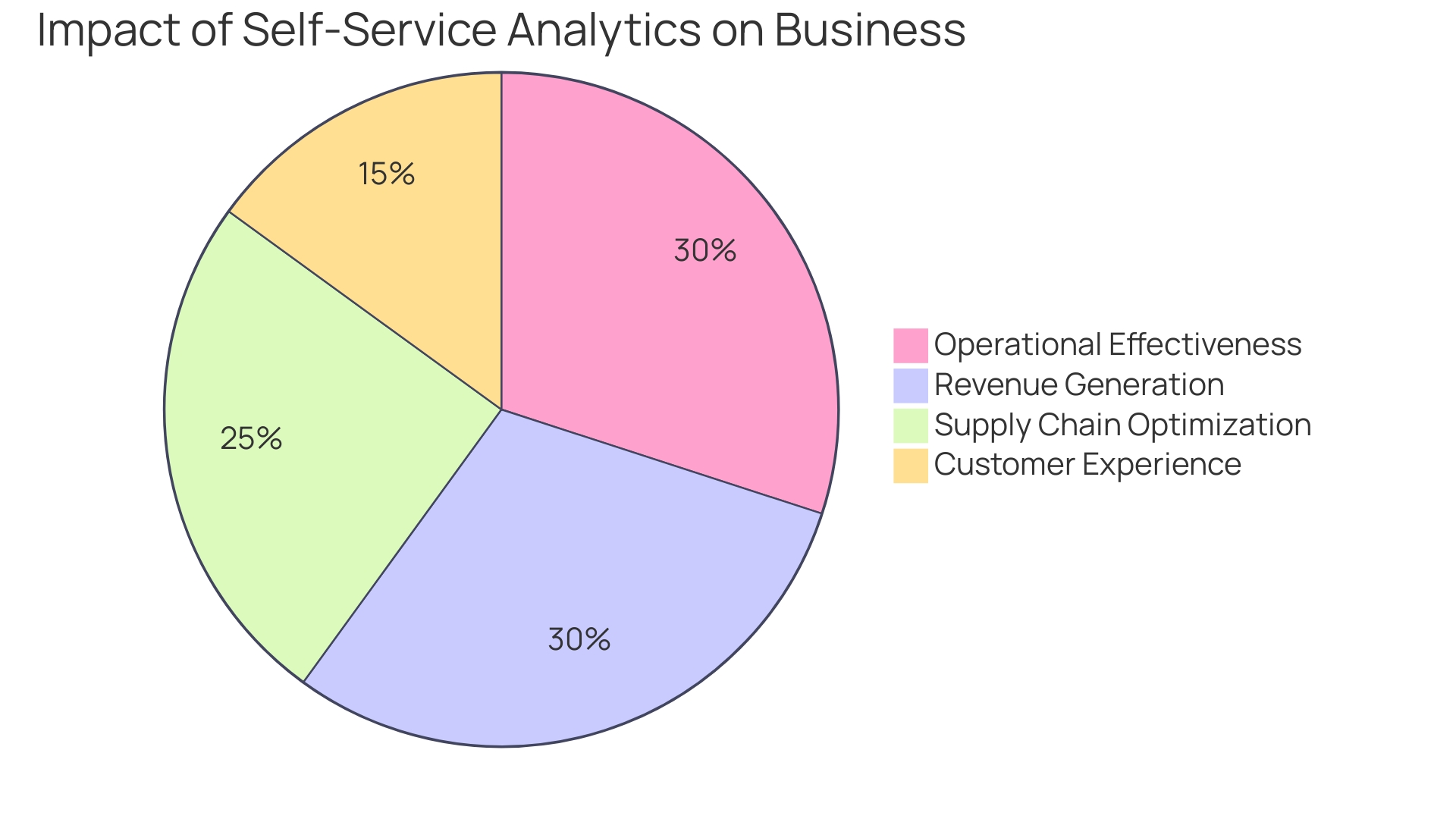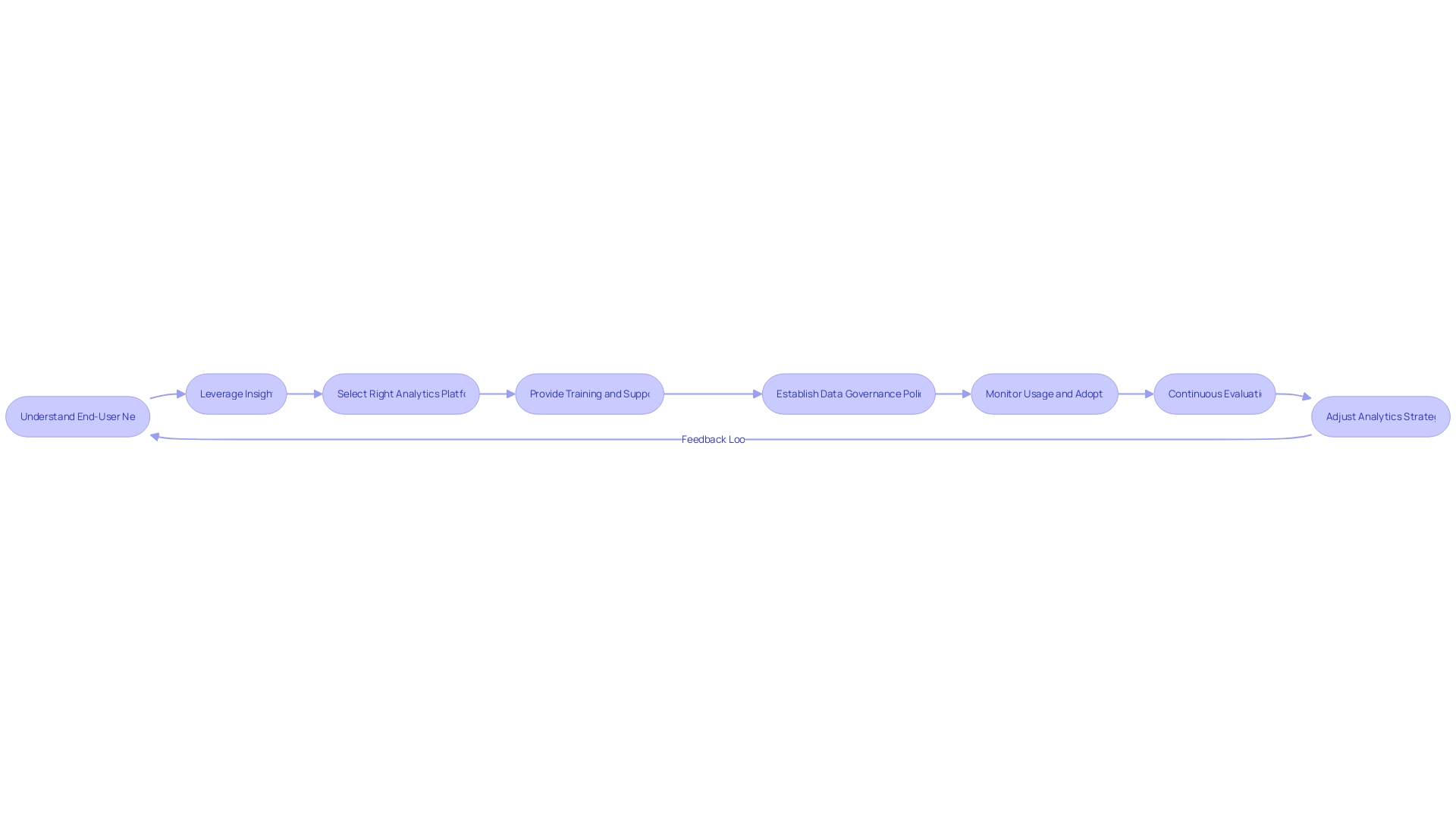Introduction
Self-service analytics has revolutionized the way businesses approach data analysis, empowering users to independently derive insights and make informed decisions. The significance of self-service analytics is underscored by its transformative impact on operational effectiveness and its projected market growth to reach $13 billion by 2025.
In this article, we will explore the benefits of self-service analytics, key steps to implementing it successfully, the importance of data literacy, overcoming historical concerns, and elevating data management practices for better insights. Join us as we delve into the world of self-service analytics and discover how it is shaping the future of data management and analytics.
What is Self-Service Analytics?
Self-service analytics has revolutionized the way businesses approach data analysis, enabling users with diverse backgrounds to independently derive insights and make informed decisions. The evolution of self-service analytics can be traced back to initiatives such as the one undertaken by the Orlando Utilities Commission's Customer Experience group.
They developed a digital dashboard to monitor water usage patterns, which empowered decision-makers to allocate resources efficiently. This initiative exemplifies the transformative impact of self-service analytics on operational effectiveness.
The significance of self-service analytics is further underscored by the fact that the analytics and business intelligence software market is projected to reach a staggering $13 billion by 2025, as reported by Gartner. This growth is a testament to the ability of analytics to uncover inefficiencies and enhance performance across various sectors.
For instance, a grocery store chain might leverage analytics to resolve supply chain issues, thereby reducing waste and improving customer satisfaction. Moreover, as the volume of data generated by systems like self-service checkouts and kiosks grows, the role of observability data becomes crucial in maintaining the health of applications and infrastructure.
This is particularly relevant for IT teams who rely on this data to preemptively identify and address potential issues. In the realm of customer experience, the power of analytics is undeniable. With 86% of consumers approving the use of artificial intelligence and 48% willing to pay more for quality service, the insights gained from analytics enable businesses to tailor their offerings for increased revenue and customer loyalty. Such insights can help identify churn indicators and enhance the overall customer journey, as well as provide personalized experiences that 46% of customers are known to value. Through the lens of self-service analytics, data is not just a resource but a product that can be leveraged to drive innovation and maintain a competitive edge. This paradigm shift towards treating data as a product is shaping the future of data management and analytics, as it encourages the exploration and application of data in new and impactful ways.

Benefits of Self-Service Analytics
Self-service analytics is revolutionizing the way companies approach data and decision-making. With the global self-service technology market poised to expand from $33.1 billion in 2021 to $76.8 billion by 2030, the potential for transformative change across industries is evident.
A profound example of this potential comes from the Orlando Utilities Commission (OUC). The OUC's Customer Experience group leveraged analytics to improve customer satisfaction by analyzing water usage data, leading to more responsible resource utilization and operational efficiencies.
Their initial focus on water meter analytics has since evolved into a comprehensive analytics operation involving a dedicated team. The benefits of embracing self-service analytics are multifaceted.
It enables faster decision-making by equipping teams with the autonomy to analyze data as needed. This autonomy, paired with a commitment to data democratization, allows for a more inclusive environment where insights can be generated and applied by a broader range of stakeholders within an organization.
Moreover, it fosters a culture of innovation and experimentation, as evidenced by the OUC's successful initiatives and the John Lewis Partnership's collaboration with Google Cloud to enhance personalized customer experiences through advanced AI and ML. However, the path to effective self-service analytics requires careful navigation. Ensuring that the technology is reliable, user-friendly, and well-supported is crucial, as is maintaining data integrity. It is essential to align the goals and efforts of central data teams with those of business users to unlock the full potential of self-service analytics. By doing so, organizations can avoid the pitfalls of a one-size-fits-all approach and instead tailor their analytics strategies to meet their unique needs and maturity levels.
Key Steps to Implementing Self-Service Analytics
The implementation of self-service analytics is more than just a technical upgrade; it's a strategic move that hinges on a deep understanding of end-user needs. For instance, Chime, a FinTech company, leveraged its Risk Analysis team's insights to monitor and protect against fraudulent transactions effectively.
Similarly, the creation of a digital dashboard enabled data-driven decision-making that maximized the use of resources. Trust Bank's choice to adopt a platform like Sumo Logic, as per CIO Rajay Rai, was driven by the need for rapid, informed decisions in a dynamic growth environment, highlighting the importance of selecting the right analytics platform that aligns with business speed and cloud-native technologies.
Providing comprehensive training and support is paramount, as evidenced by the operational efficiencies gained from intuitive self-service solutions, like those highlighted by Networld Media Group's Daniel Brown. The success of these tools lies in their user-centric design, which allows for widespread adoption without extensive manuals.
Furthermore, the establishment of robust data governance policies ensures the integrity and reliability of the data, a non-negotiable aspect as businesses like John Lewis Partnership commit £100 million to their digital transformation with Google Cloud. This investment in advanced AI and ML technologies underscores the trend towards personalized customer experiences, which rely on high-quality, insightful data. Lastly, monitoring usage and adoption is critical. A global survey of respondents from 30 countries, conducted between December 8, 2023, and January 22, 2024, emphasizes that performance scores and insights can evolve, especially in emerging markets. This reinforces the need for continuous evaluation and adjustment of analytics strategies to maintain relevance and effectiveness in an ever-changing market.

Empowering Business Users with Data Literacy
With the rise of data democratization in the business environment, it's become clear that fostering data literacy is not just beneficial; it's essential for organizational growth. As we pivot from traditional dashboard-centric analytics to more dynamic and interactive platforms like Slack, the engagement with data skyrockets. In one case, the number of users actively engaging with data through such platforms far exceeded those using conventional dashboard tools.
This represents a transformation from a 'pull' to a 'push' approach in insights discovery, streamlining the effort required to access critical information and enhancing clarity around key metrics. This strategic shift allows teams to pinpoint specific areas of the business funnel that need attention, such as when launching new products, and focus efforts more effectively. The importance of self-service analytics is further underscored by the prediction that the analytics and business intelligence software market will double by 2025, reaching a value of $13 billion.
As Sharang Sharma, vice president of business process services at Everest Group, highlights, the capacity of modern tools to process and generate insights from vast amounts of data is 'phenomenal.' These insights are not only helping businesses identify and rectify inefficiencies but also driving better decision-making and operational enhancements across various industries. For instance, a grocery chain might use data analytics to resolve supply chain bottlenecks, while an insurance company could gain operational insights from HR data to optimize performance.
However, the realization of these benefits hinges on a workforce that is data-literate — capable of interpreting and leveraging data to its full potential. Despite advancements in technology, less than 2% of business leaders prioritize data literacy as an investment, which may explain the limited success in data-driven initiatives. By centralizing data and educating all team members, not just IT and data science professionals, in data interpretation, organizations can remove bottlenecks, improve collaboration, and ultimately, drive better business outcomes.
Overcoming Historical Concerns with Self-Service Analytics
The landscape of data analytics has undergone a significant transformation, with the analytics and business intelligence software market poised to reach a staggering $13 billion by 2025, according to Gartner research. This growth is a testament to the advancements in technology that have not only heightened data security but have also enhanced data quality and interpretation. Innovations in data governance practices are enabling organizations to harness the full potential of their data.
For instance, the Orlando Utilities Commission's investment in customer data and analytics over the past decade has led to valuable operational insights, such as identifying abnormal water usage patterns. This has resulted in an expanded analytics team and more informed decision-making processes. Similarly, agile methodologies have been refined to ensure that data-driven projects remain aligned with strategic business goals, emphasizing the importance of business stakeholders owning and understanding their data.
Furthermore, the rise of distributed Data Management, as highlighted by the emerging data anti-gravity trend, is shifting the focus towards treating data products with the same level of importance as traditional product offerings. This approach is exemplified by Unilever's People Data Center, which has developed tailored analytics methods to delve into unstructured text data, yielding crucial insights for various business functions. As we move into 2024, organizations are preparing for an environment where data is increasingly distributed, and the role of IT is evolving to support the creation and distribution of data products across enterprise domains.

Elevating Data Management Practices for Better Insights
As the demand for insightful data analysis intensifies, the role of self-service analytics has become increasingly pivotal. At the Orlando Utilities Commission (OUC), a transformation began with the Customer Experience group's initiative to leverage customer data for actionable insights.
Their success story underscores the importance of robust data management, including governance and validation, to ensure accuracy and relevance of self-service analytics. The journey of Air India, aiming for a 30% market share, illustrates the challenges of decentralized data in delivering consistent customer experiences.
Their proactive approach to consolidating data sources into a unified view showcases the significance of a centralized data strategy. John Lewis Partnership's collaboration with Google Cloud, valued at £100 million, exemplifies the strategic investment in infrastructure to harness advanced AI and ML capabilities.
This move is aimed at enhancing efficiency and personalizing customer interactions, which are key components of an effective self-service analytics framework. These case studies, coupled with the notion that 'data is valuable' and should be treated 'as a product', reflect the transformative power of self-service analytics. It empowers end-users to generate their own insights, fostering a culture of collaboration and informed decision-making. As organizations with a greater number of data tables have shown, a commitment to data quality correlates with faster issue detection and resolution times, reinforcing the critical nature of data management practices for self-service analytics to thrive.

Conclusion
In conclusion, self-service analytics has revolutionized data analysis, empowering users to independently derive insights and make informed decisions. Its transformative impact on operational effectiveness is evident, as exemplified by initiatives like the Orlando Utilities Commission's digital dashboard for monitoring water usage patterns. The projected market growth of self-service analytics to reach $13 billion by 2025 underscores its significance in uncovering inefficiencies and enhancing performance across sectors.
Benefits include faster decision-making, a more inclusive environment for data democratization, and fostering a culture of innovation. Implementing self-service analytics requires selecting the right platform, providing comprehensive training and support, establishing robust data governance policies, and continuously monitoring usage and adoption. Data literacy plays a crucial role in unlocking the benefits of self-service analytics.
By centralizing data and educating all team members in interpretation, organizations can remove bottlenecks and drive better business outcomes. Advancements in technology have addressed historical concerns with self-service analytics, enhancing data security, quality, and interpretation. Elevating data management practices is essential for better insights.
Robust governance ensures accuracy and relevance. In conclusion, self-service analytics shapes the future of data management by empowering users to derive insights independently. By embracing this approach, businesses can unlock efficiencies, drive innovation, improve decision-making processes, and stay ahead in a competitive landscape.





